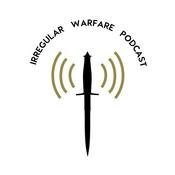118 episodes

120 S01 Ep 38 – The Large Scale Combat Operations Symposium of Fiscal Year 2026 w/BG Jason Curl & COL Ricky Taylor
19/12/2025 | 1h 57 mins.
The Joint Readiness Training Center is pleased to present the one-hundredth-and-twentieth episode to air on ‘The Crucible - The JRTC Experience’ and the fifth* annual Large Scale Combat Operations Symposium. Hosted by COL Ricky Taylor, the Commander of Ops Group (COG). Today’s guests are all seasoned observer-coach-trainers (OCTs) from across Operations Group, LTC Amoreena “Ammo” York, MAJ David Pfaltzgraff, MAJ Marc Howle, MAJ Amy Beatty, MAJ Jeff Horn, CSM Frank Enriquez, SGM Matthew Bollinger, and MSG Lacey Remillard as well as CW3 Roy Sandoval from the US Army Special Operations Command’s Special Operations Training Detachment. Opening remarks were provided by GEN David Hodnes (Available only live via Teams), the Commanding General of Transformation and Training Command (T2COM) and BG Jason Curl, the Commanding General of the Joint Readiness Training Center. Our panel members are observer-coach-trainers with numerous decisive action training environment rotations between them. LTC York is the Task Force Senior for the TF Aviation (CAB / ATF). MAJ Pfaltzgraff is the BDE S-3 Operations OCT and MAJ Howle is the Protection OCT for Brigade Command & Control (BDE HQ). MAJ Beatty is the Executive Officer OCT and MSG Remillard is the S-3 Operations Sergeant Major OCT for Task Force Sustainment (BSB/DSSB). MAJ Horn is the Executive Officer OCT for the Fires Support Task Force. CSM Enriquez is the Command Sergeant Major OCT for Live Fires Division. SGM Bollinger is the Senior Enlisted S-2 Intelligence Advisor for the Intelligence Warfighting Function. CW3 Sandoval is the Rotational Planner for USASOC’s Special Operations Training Detachment. The purpose of the ‘LSCO Symposium’ is to advance conversation on warfighting and share observations and lessons learned. We will discuss large scale violence today, but this discussion transcends mission sets. Train for high end competition and scale down as required. This episode synthesizes JRTC trends and best practices for preparing units for their hardest days of ground combat in Large-Scale Combat Operations across multiple domains. A central theme is that continuous transformation must be anchored to disciplined fundamentals. Leaders repeatedly emphasize that emerging capabilities—UAS, ITN, AI-enabled targeting tools, precision fires, and advanced sustainment systems—amplify poor discipline as much as they amplify competence. Units struggle when they trade foundational skills for technology, compress training timelines, or assume proficiency in basics like MDMP rigor, rehearsals, reporting, security, and sustainment forecasting. The discussion reinforces that formations are not failing because of a lack of tools, but because of gaps in training management, insufficient repetitions at home station, and an erosion of shared doctrinal language that enables synchronization under stress. The episode also highlights how LSCO success depends on integration across warfighting functions over time, not single moments of convergence. Best-performing units demonstrate disciplined commander–staff and commander–commander dialogue, deliberate risk articulation, and active NCO involvement throughout planning and execution. Persistent challenges include rushed or truncated MDMP, weak course-of-action analysis, fragmented IPO/SPO processes, and poor sustainment visibility that leads to overstocking, vulnerable cache sites, and exposed logistics nodes. Survivability on a transparent battlefield emerges as a recurring lesson: units must balance dispersion with functionality, manage electromagnetic signatures, rehearse degraded communications, protect sustainment forces, and treat rear areas as contested terrain. Taken together, the episode underscores a clear JRTC message—winning the first battles of LSCO requires disciplined fundamentals, rigorous planning, and relentless rehearsal long before units ever make contact. Part of S01 “The Leader’s Laboratory” series. Don’t forget to checkout our first, second, third, and fourth annual Large Scale Combat Operations Symposium, episodes sixteen, thirty, sixty-six, and ninety-three of ‘The Crucible.’ For additional information and insights from this episode, please check-out our Instagram page @the_jrtc_crucible_podcast. Be sure to follow us on social media to keep up with the latest warfighting TTPs learned through the crucible that is the Joint Readiness Training Center. Follow us by going to: https://linktr.ee/jrtc and then selecting your preferred podcast format. Again, we’d like to thank our guests for participating. Don’t forget to like, subscribe, and review us wherever you listen or watch your podcasts — and be sure to stay tuned for more in the near future. “The Crucible – The JRTC Experience” is a product of the Joint Readiness Training Center. *The first annual LSCO Symposium was conducted at Ft. Benning/Moore but hosted by the JRTC Team.

119 S01 Ep 37 – Light Forces, Heavy Problems: Airborne Division Lessons Learned from the Friction Factory w/All American 06, MG Brandon Tegtmeier
18/12/2025 | 1h 5 mins.
The Joint Readiness Training Center is pleased to present the one-hundredth-and-nineteenth episode to air on ‘The Crucible - The JRTC Experience.’ Hosted by COL Ricky Taylor, the Commander of Ops Group (COG). Today’s guest is the Commanding General for the fabled 82nd Airborne Division, MG Brandon Tegtmeier, All American 06. The 82nd Airborne Division specializes in joint forcible entry operations via vertical envelopment, both airborne and air assault, into denied areas with a U.S. Department of Defense requirement to respond to crisis contingencies anywhere in the world within 18 hours. They have the Hollywood call-sign of “All American” Division and the motto of “In Air, On Land.” This episode explores trends and best practices observed through the lens of an airborne division preparing for large-scale combat operations, with a consistent emphasis on fundamentals, training management, and condition setting at echelon. The discussion reinforces that success at division level is anchored in company-level and below proficiency, arguing that brigades and divisions can adapt rapidly during a CTC rotation, but deficiencies in small-unit fundamentals cannot be fixed once in contact. A recurring theme is the deliberate decompression of training—allowing platoons, companies, and battalions sufficient time to learn, rehearse, and apply lessons rather than rushing through compressed events. This approach enables leaders to internalize battle drills, reduce cognitive load under stress, and fight effectively in JRTC’s “friction factory,” where units are tested under sustained pressure, casualties, logistics shortfalls, and enemy contact. From an operational perspective, the episode highlights how airborne formations must think differently about setting conditions across the fight, integrating intelligence, fires, sustainment, protection, and deception over time rather than relying on single convergence moments. Key topics include commander-driven MDMP, disciplined risk dialogue between commanders and staffs, and the necessity of clearly articulating information requirements to higher headquarters when organic collection assets are limited. The conversation also addresses emerging best practices such as protecting long-range fires, using maneuver forces to enable deep effects, embracing deception and EMCON to survive on a transparent battlefield, and offloading risk to robotics and UAS through formations like the MFRC. Sustainment realities for light forces—especially water and ammunition management following airborne or austere insertions—are repeatedly emphasized as decisive factors. Taken together, the episode presents a clear message: airborne divisions win by mastering fundamentals, deliberately preparing leaders at every echelon, and synchronizing effects over time to preserve combat power and maintain momentum in LSCO. Part of S01 “The Leader’s Laboratory” series. Don’t forget to check-out XVIII Airborne Corps’ social media pages, their handles are ‘82ndAirborneDivision’ on Facebook, ‘82ndABNDiv’ on X, and ‘82ndairbornediv’ on Instagram. For additional information and insights from this episode, please check-out our Instagram page @the_jrtc_crucible_podcast. Be sure to follow us on social media to keep up with the latest warfighting TTPs learned through the crucible that is the Joint Readiness Training Center. Follow us by going to: https://linktr.ee/jrtc and then selecting your preferred podcast format. Again, we’d like to thank our guests for participating. Don’t forget to like, subscribe, and review us wherever you listen or watch your podcasts — and be sure to stay tuned for more in the near future. “The Crucible – The JRTC Experience” is a product of the Joint Readiness Training Center.

118 S05 Ep 09 – Triage Tips the Scales: Combat Medicine Realities in Large Scale Combat Operations with Combat Medicine Professionals of JRTC
11/12/2025 | 1h 10 mins.
The Joint Readiness Training Center is pleased to present the one-hundredth-and-eighteenth episode to air on ‘The Crucible - The JRTC Experience.’ Hosted by the Senior Enlisted Medical Advisor and Role II Observer-Coach-Trainer for the Task Force Sustainment (BSB / CSSB), MSG Timothy Sargent on behalf of the Commander of Ops Group (COG). Today’s guests are all combat medicine professionals across the JRTC. SFC William Deutsch is the Senior Medical OCT with TF-3 (IN BN), SFC Robert Schimmelpfenneg is the Medical Advisor and Role II OCT with TF Sustainment (BSB / CSSB), and SFC Anthony Norris is the Senior Medical OCT with Live Fire Division. This episode dives deep into combat medicine at the tactical small-unit level, focusing on what 68W medics truly face in a large-scale combat operations environment. The discussion highlights how today’s medics arrive from Basic Combat Training and Advanced Individual Training with significantly more clinical capability: whole blood transfusions, chest tubes, finger thoracotomies, FAST exams, etc. Yet often lose proficiency once they reach their units due to lack of repetitions, limited clinical exposure, and competing taskings like motor-pool duties and gate guard. The panel emphasizes the widening gap between what new medics learn in the schoolhouse and what line units actually reinforce day to day. Just as importantly, the episode stresses that modern LSCO demands a return to mastery of basics: triage under mass-casualty conditions, reassessments, deliberate casualty collection point (CCP) management, documentation, and base-level soldier tasks such as security, dispersion, movement, and survivability. We routinely observe high-casualties at JRTC, often 60–80 casualties at once and hundreds per rotation. Poor triage and poor soldier-skill fundamentals, not lack of “sexy medicine,” are the leading causes of died-of-wounds outcomes. The episode also examines how units can better sustain medical readiness during home-station training. Leaders discuss integrating medics into ER rotations, EMS ride-alongs, sick-call operations, and realistic trauma/medical lanes that reinforce both prolonged field care and everyday DMBI cases. They argue that NCOs must reclaim ownership of training through proper DTMS programming, use of existing doctrinal resources, and deliberate linkage to mission-essential tasks. The conversation closes on three high-value priorities for the future fight: deliberate triage, accurate/documented patient care, and competent CCP & CASEVAC execution—all grounded in disciplined soldiering, not just advanced interventions. Ultimately, the episode makes clear that on the LSCO battlefield, combat medics must be clinicians, communicators, and soldiers, capable of saving lives while enabling commanders to maintain combat power forward. Part of S05 “Beans, Bullets, Band-Aids, Batteries, Water, & Fuel” series. For additional information and insights from this episode, please check-out our Instagram page @the_jrtc_crucible_podcast Be sure to follow us on social media to keep up with the latest warfighting TTPs learned through the crucible that is the Joint Readiness Training Center. Follow us by going to: https://linktr.ee/jrtc and then selecting your preferred podcast format. Again, we’d like to thank our guests for participating. Don’t forget to like, subscribe, and review us wherever you listen or watch your podcasts — and be sure to stay tuned for more in the near future. “The Crucible – The JRTC Experience” is a product of the Joint Readiness Training Center.

117 S13 Ep 06 - Ammo, Assumptions, and the Artillery Fight: Lessons from the Box w/the JRTC Fires Support Task Force
27/11/2025 | 26 mins.
The Joint Readiness Training Center is pleased to present the one-hundredth-and-seventeenth episode to air on ‘The Crucible - The JRTC Experience.’ Hosted by MAJ Marc Howle, the Brigade Senior Engineer / Protection Observer-Coach-Trainer, and MAJ David Pfaltzgraff, BDE S-3 Operations OCT, from Brigade Command & Control (BDE HQ) on behalf of the Commander of Ops Group (COG). Today’s guests are senior members of JRTC’s fires support enterprise: MAJ Jeff Horn, MSG Esteban Melendez, and SFC Larry Gillispie, Jr. MAJ Horn is the Executive Officer OCT for the Fires Support Task Force. MSG Melendez is the Battery Senior NCO OCT and SFC Gillispie is the Fires Direction Center Senior OCT for the Fires Support TF. This episode centers on the critical role of indirect fires in enabling brigade and battalion maneuver during large-scale combat operations (LSCO). Discussion emphasized how modern battlefields—defined by continuous observation, rapid enemy counterfire, and contested electromagnetic terrain—demand faster, simpler, and more integrated fires processes. The episode explored the necessity of marrying intelligence, targeting, and maneuver to generate timely and accurate effects, noting that units frequently struggle with building effective EVENTEMPs, aligning priority intelligence requirements with high-payoff target lists, and ensuring fire support elements understand the commander’s visualization. Indirect fires are no longer a supporting arm that can be “plugged in” at the end of planning; instead, fires must lead maneuver, set conditions, disrupt enemy reconnaissance, and shape the tempo of operations. Units that succeeded at JRTC did so by developing disciplined fires rehearsals, maintaining digital pathways for observers and FSEs, and employing simple, survivable fire support plans that could be executed under degraded conditions. The episode also examined common shortfalls in fire support execution and provided practical solutions rooted in LSCO best practices. Many units struggled to connect sensors to shooters, often due to poor task organization, inconsistent digital connectivity, or a lack of rehearsed triggers and decision points. The conversation stressed that fires must be integrated early, beginning at WARNO 1, so that reconnaissance, counter-reconnaissance, and targeting all feed a coherent fires architecture. Leaders must enforce conditions that enable fires in contact: dispersed artillery positions, rapid survivability moves, redundant communications, and timely, accurate reporting. Best practices discussed included using decoys to force enemy action, leveraging sUAS for battle damage assessment and real-time refinement, simplifying TLWS/TTLODAC products, and conducting thorough fires technical rehearsals. Ultimately, the episode reinforced that mastery of indirect fires is inseparable from mastery of LSCO itself—units that can sense, decide, and deliver effects faster than the enemy preserve freedom of maneuver and dominate the fight. Part of S13 “Hip Pocket Training” series. For additional information and insights from this episode, please check-out our Instagram page @the_jrtc_crucible_podcast Be sure to follow us on social media to keep up with the latest warfighting TTPs learned through the crucible that is the Joint Readiness Training Center. Follow us by going to: https://linktr.ee/jrtc and then selecting your preferred podcast format. Again, we’d like to thank our guests for participating. Don’t forget to like, subscribe, and review us wherever you listen or watch your podcasts — and be sure to stay tuned for more in the near future. “The Crucible – The JRTC Experience” is a product of the Joint Readiness Training Center.

116 S05 Ep 08 – The Joint Aid Station-Rear and Beyond: Medical Coordination from the Line to the Rear at the JRTC
02/10/2025 | 52 mins.
The Joint Readiness Training Center is pleased to present the one-hundredth-and-sixteenth episode to air on ‘The Crucible - The JRTC Experience.’ Hosted by the Senior Medical Operations Officer Observer-Coach-Trainer for the Task Force Sustainment (BSB / CSSB), CPT Victor Velez on behalf of the Commander of Ops Group (COG). Today’s guest is CPT Christina Pierce, the Officer-in-Charge, Joint Aid Station-Rear (JAS-R) attached to Bayne Jones Army Community Hospital on Fort Polk, LA. This episode of The Crucible podcast focuses on the coordination and integration of medical operations from Role I through Role 2+, with particular emphasis on the Joint Aid Station-Rear (JAS-R) at the JRTC. The discussion outlines how units often underestimate the staffing, equipment, and Class VIII requirements needed to effectively run a JAS-R. Leaders are reminded that the JAS-R is designed to function as a Role I facility with limited expansion, and its true effectiveness is shaped by what the unit brings—particularly providers, medics, and a robust Class VIII package. A bare minimum staffing model (one provider and 12 medics split across shifts) is described as unsustainable, with best practices suggesting multiple providers and additional medics to manage patient flow, casualty movement, and external appointments. The podcast highlights how equipment such as exam tables, AEDs, suction systems, and crash carts are available in the facility, but units must stock and maintain them. The conversation further emphasizes coordination with JRTC JAS-R staff and Bayne-Jones Army Community Hospital (BJACH) at Ft. Polk to ensure proper credentialing, MHS Genesis access, and Class VIII ordering prior to arrival. Units are cautioned against arriving with inadequate supplies or relying solely on CTC funds allocation for replenishment, which is intended for sustainment, not initial stocking. Critical points include managing referrals to BJACH and local civilian hospitals, establishing transportation plans for follow-up care, and ensuring effective communication between providers, medics, and the white cell for accountability and patient tracking. The episode stresses that medical planning is not just a surgeon’s responsibility but a command responsibility, and leaders must treat the JAS-R as a training opportunity and readiness rehearsal for the demands of LSCO. Part of S05 “Beans, Bullets, Band-Aids, Batteries, Water, & Fuel” series. For additional information and insights from this episode, please check-out our Instagram page @the_jrtc_crucible_podcast Be sure to follow us on social media to keep up with the latest warfighting TTPs learned through the crucible that is the Joint Readiness Training Center. Follow us by going to: https://linktr.ee/jrtc and then selecting your preferred podcast format. Again, we’d like to thank our guests for participating. Don’t forget to like, subscribe, and review us wherever you listen or watch your podcasts — and be sure to stay tuned for more in the near future. “The Crucible – The JRTC Experience” is a product of the Joint Readiness Training Center.
More Government podcasts
Trending Government podcasts
About The Crucible - The JRTC Experience Podcast
Listen to The Crucible - The JRTC Experience Podcast, The Interview and many other podcasts from around the world with the radio.net app

Get the free radio.net app
- Stations and podcasts to bookmark
- Stream via Wi-Fi or Bluetooth
- Supports Carplay & Android Auto
- Many other app features
Get the free radio.net app
- Stations and podcasts to bookmark
- Stream via Wi-Fi or Bluetooth
- Supports Carplay & Android Auto
- Many other app features


The Crucible - The JRTC Experience Podcast
download the app,
start listening.




































